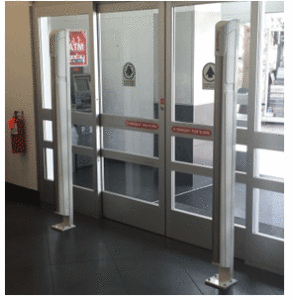 Employee theft continues to rise. In some retail settings it’s surpassed customer theft. There are a variety of reasons for the increase. One of them is that many managers have a hard time believing that “My people would do such a thing”. And because they have a hard time believing it they don’t take steps to combat it.
Employee theft continues to rise. In some retail settings it’s surpassed customer theft. There are a variety of reasons for the increase. One of them is that many managers have a hard time believing that “My people would do such a thing”. And because they have a hard time believing it they don’t take steps to combat it.
Here are some of the things they say: “It’s not in my personality to believe the worst of people.” “I try to promote a family atmosphere.” “I don’t want to offend the honest employees by punishing everybody for the few bad apples”. “I don’t want to be a security guard.” “I want my store to be a place where people like to come to work.”
But, whether you want to believe it or not, chances are your staff has, is and will steal from the store. So, what do you do? How do you balance stopping the thieves, while not alienating the honest people? Conscientious managers struggle with these questions. Here are a few answers.
Do surprise register checks – Random cash drawer reconciliations let everyone know you’re paying attention, while not singling anyone out. It’s business, not personal.
Highlight inventory control – Have all staff members take turns helping you spot check inventory records with actual product. Let them know you take missing items and incomplete records seriously. Employee theft thrives on a manager’s inattention to detail.
Check the tapes – Tell and show your employees that you check the tapes. Are the z-tape’s numbers sequential? If not, why not and who’s responsible? What are the average “no-sale” numbers (x-tapes)? Do they go up on a certain shift or day? If so, why and who was working? Asking for explanations is not the same as making accusations.
Promote anonymous tips – We all have ideas about “narcing, snitching and tattling,” many of them negative. But, it’s one of the most effective ways to stop workplace fraud. It gives people the chance to step forward without fear of retaliation.
However, a tip is not a fact and shouldn’t be seen as one. It’s a starting place for you to carefully look into the accusation. A tip can’t be used to get back at someone or unfairly accuse them if you are thoughtful and cautious about pursuing it.
There isn’t a way to completely stop employee theft. But, if you make it difficult most won’t try it and others will get caught quickly, which increases staff morale. Honest, hard working people don’t want to work in a store where management turns a blind or incompetent eye on dishonesty. They want a store that’s fair, openhanded and safe for everyone.
Nicole Abbott is a professional writer who’s had over 150 articles published. She’s a business consultant and former psycho-therapist with over 20 years of experience in mental health, business and addiction. She’s a coach, lecturer, trainer and facilitator. She has conducted over 200 workshops, trainings, presentations, seminars and college classes.

 Are you confused about how to stop shoplifters? Many Retailers are. Often I hear something like “I have a CCTV camera system to stop shoplifters”. The reality is that shoplifters couldn’t care less. Cameras are a very tiny deterrent to a shoplifter. They know you do not have the time or payroll dollars to actively watch. And it is easy enough to create a diversion or simply take your merchandise and move to another location in your store that does not have camera coverage.
Are you confused about how to stop shoplifters? Many Retailers are. Often I hear something like “I have a CCTV camera system to stop shoplifters”. The reality is that shoplifters couldn’t care less. Cameras are a very tiny deterrent to a shoplifter. They know you do not have the time or payroll dollars to actively watch. And it is easy enough to create a diversion or simply take your merchandise and move to another location in your store that does not have camera coverage.  EAS is great isn’t it? For the most part, if someone is stealing product “X,” you slap on a quick tag or label and you see a pretty substantial reduction in shrink (for the most part.… Live in the real world). As my LP career has progressed over the years, I’ve seen EAS change drastically. I’ve also seen what retailers apply EAS tags to change as well. Often times, I scratch my head in disbelief at the ideas that come out sometimes and others, I pull my hair out because we could have been more proactive with tag placement. I’ve also seen some fantastic ideas from my store teams on some not so standard tagging procedures.
EAS is great isn’t it? For the most part, if someone is stealing product “X,” you slap on a quick tag or label and you see a pretty substantial reduction in shrink (for the most part.… Live in the real world). As my LP career has progressed over the years, I’ve seen EAS change drastically. I’ve also seen what retailers apply EAS tags to change as well. Often times, I scratch my head in disbelief at the ideas that come out sometimes and others, I pull my hair out because we could have been more proactive with tag placement. I’ve also seen some fantastic ideas from my store teams on some not so standard tagging procedures. Often overlooked for small businesses is the dire need for a suitable burglar alarm system. I talk about EAS placement and CCTV all the time. Those are rendered absolutely useless is someone busts in through the back door. If your burglar system isn’t up to standards, you run the risk of losing everything.
Often overlooked for small businesses is the dire need for a suitable burglar alarm system. I talk about EAS placement and CCTV all the time. Those are rendered absolutely useless is someone busts in through the back door. If your burglar system isn’t up to standards, you run the risk of losing everything.
 In the UK the number of women apprehended for shoplifting has increased, and has been linked to the fact that they do no longer get government benefits. In the United States shoplifting has increased with millions of dollars lost due to shoplifting every year, and the increase in prices has led many thieves to shoplift items that were unthinkable not too long ago. With the increase of beef prices for example, the number of thieves stealing package meat has reached an all time high. Stores across the country are even considering putting anti-theft packaging on their meat products to prevent thieves from shoplifting it.
In the UK the number of women apprehended for shoplifting has increased, and has been linked to the fact that they do no longer get government benefits. In the United States shoplifting has increased with millions of dollars lost due to shoplifting every year, and the increase in prices has led many thieves to shoplift items that were unthinkable not too long ago. With the increase of beef prices for example, the number of thieves stealing package meat has reached an all time high. Stores across the country are even considering putting anti-theft packaging on their meat products to prevent thieves from shoplifting it.
